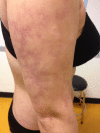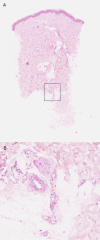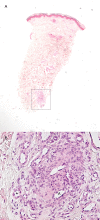The diagnostic value of skin biopsies in Sneddon syndrome
- PMID: 34181656
- PMCID: PMC8238230
- DOI: 10.1371/journal.pone.0253365
The diagnostic value of skin biopsies in Sneddon syndrome
Erratum in
-
Correction: The diagnostic value of skin biopsies in Sneddon syndrome.PLoS One. 2024 Nov 27;19(11):e0314784. doi: 10.1371/journal.pone.0314784. eCollection 2024. PLoS One. 2024. PMID: 39602428 Free PMC article.
Abstract
Background: Sneddon syndrome (SS) is defined by widespread livedo reticularis (LR) and stroke. There is no single diagnostic test for SS and diagnosis can be solely based on clinical features. This cross-sectional case-control study aimed to determine the diagnostic value of skin biopsies in SS patients.
Materials and methods: We studied skin biopsies from patients with a clinical diagnosis of SS or isolated LR. We also studied controls with vitiligo or normal skin. Biopsies were considered standardized if 3 biopsies were taken from the white centre of the livedo and reached until the dermis-subcutis border. Biopsies were scored for features of an occlusive microangiopathy without knowledge of the clinical features. Sensitivity and specificity of the biopsy findings were calculated with the clinical criteria as the reference standard.
Results: We included 34 SS patients, 14 isolated LR patients and 41 control patients. Biopsies of 17 patients with SS (50%), 4 with isolated LR (31%) and 10 control patients (24%) showed at least one artery in the deep dermis with a thickened vessel wall combined with recanalization or neovascularization (sensitivity 50% and specificity 69% with LR as reference). Standardized biopsies increased the sensitivity to 70%. In a post hoc analysis the combination of an occlusive microangiopathy and the presence of a livedo pattern in the superficial dermis increased the specificity to 92%.
Conclusions: Standardized skin biopsies can support the clinical diagnosis of SS. An occlusive microangiopathy as the only positive criterion for the diagnosis of SS had insufficient specificity for a definite diagnosis.
Conflict of interest statement
The authors have declared that no competing interests exist.
Figures




References
MeSH terms
LinkOut - more resources
Full Text Sources

